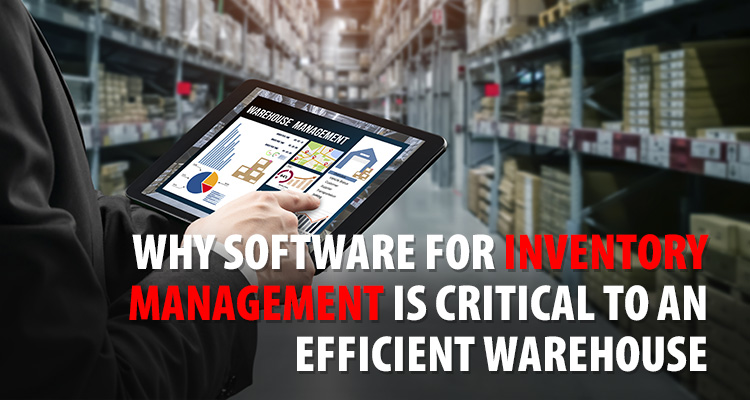Why Software for Inventory Management is Critical to an Efficient Warehouse

Lisa Schwarz | Sr. Director of Global Product Marketing
Since primitive agrarian societies began storing seeds and foodstuffs, people have been seeking for ways to better manage their inventory.
Those steps took a big leap forward in 1973, with the inception of the Universal Product Code at grocery stores in the United States and Canada. Retailers, distributors and manufacturers that had been seeking ways to better track, manage and understand their inventory now at least had an agreed upon standard for their technology. Through the hype of RFID in the mid to late ‘90s, to advancements in sensor technology to the promise of the Internet of Things, the methods of managing inventory have steadily improved. Yet, far too many organizations are still stuck conducting manual counts, keeping information on spreadsheets, or worse clipboards, and unwilling to make the investment in technology that has been proven to improve inventory management.
While handheld scanners and the IoT may sound sexier, the first place to begin is with software for managing inventory.
What is Software for Inventory Management?
Software that tracks inventory does far more than account for what’s on a store room shelf or warehouse pallet. Sophisticated inventory tracking software will also account for parts, what partners or important customers have on hand and more. Just as importantly, inventory management software doesn’t just account for number and location. Properly integrated with an accounting or ERP software package, it tracks items across acquisition, sale and age for products like perishable goods. From there, an inventory management system should also be able to track items or parts across multiple warehouses and be able to conduct currency conversions for inventory located abroad.
For retailers, software for managing inventory should also be integrated with Point of Sale (POS) data so that organizations have real-time insights into stock levels and can avoid the impact of stock outs on the customer experience.
The functionality that software for managing inventory provides includes, but is not limited to: reorder point tracking, alerting manager when inventory is running too low or too high; asset tracking, using bar codes, RFID or other sensors to determine the exact location of a piece of inventory; service management, to track the cost of service materials; product identification; and inventory identification, automated demand forecasting and tracking of the top inventory management metrics.
What Can Inventory Management Software do for the Warehouse?
The key to any successful warehouse operation is efficiency. Any business still managing their inventory with pen and paper, email or even spreadsheets is destined to fall behind its competitors in the industry due to the inefficiencies that creates.
Here are some of the inefficiencies that software for inventory management can address in the warehouse:
Mispicks and missed shipments: Mistakes in picking inventory thanks to human error can be costly for a warehouse in lost time. When those items are then shipped, it becomes even more costly with returned shipments, lost of customer trust and rushed orders. Software can help eliminate most, if not all, of these mistakes with barcoding, QRs and other sensor technology, as well as bin management, ensuring warehouse staff pull the right inventory at the right time, regardless of training.
Counting Errors: Annual or twice annual inventory checks where the whole staff gathers to go over inventory through manual accounts needs to become a thing of the past. Even these counts are done manually introducing the chance of errors. And what happens the rest of the year? Are businesses satisfied to only have an accurate count of inventory part of the time? Automated systems with scanners that stores data centrally and is updated in real-time ensure accurate counts and eliminating additional administrative costs and inefficiencies.
Manual picking: One of the greatest expenses of any warehouse is staffing. Therefore, being efficient with picking time is one of the areas software for inventory management can best address. Modern software packages can not only inform staff where inventory is located, but the best route to take when pulling multiple orders. Armed with this information, warehouse personnel can do more work in less time. Additionally, when turnover occurs, it doesn’t take new staff members months to understand the layout of the warehouse and the location of items.
Overstock/Understock: Warehouses confront a difficult dilemma in how much inventory they keep on hand. Carry too much inventory and your capital is tied up in products that aren’t being sold. Moreover, there are costs to store and manage that inventory, particularly items with limited shelf life. Carry too little however, and the business runs the risk of stock outs and an inability to meet customer demand. Modern inventory management systems, particularly those tightly integrated with the ERP system, can help with forecasting and demand planning, ensuring that the perfect amount of inventory is kept on hand. And, as advances are made in artificial intelligence and the technology reaches the warehouse, that can help businesses account for previously unforeseen circumstances based on things like the weather, customer demand or any range of events that can impact demand for the product.
Reconciling incoming shipments: Too many warehouses still rely on manual processes for counting and reconciling incoming shipments, which can be error-prone and costly. Barcode scanners and other sensors tied into a warehouse management system not only reduce those errors but make for better working conditions for employees, leading to greater employee loyalty, and less turnover and training.






